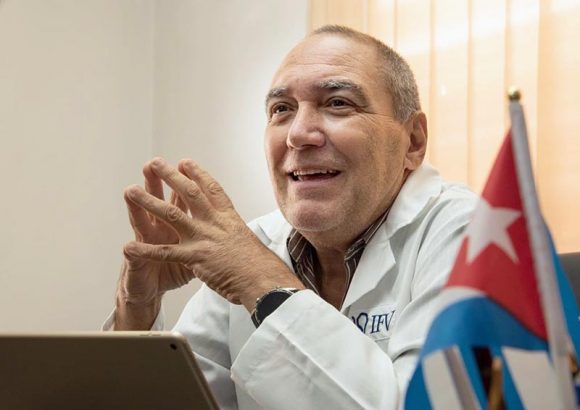How Cuba became a pioneer in covid-19 vaccines for kids
The Washington Post | Tuesday, 21 June 2022 | Click here for original article

Long before he was declared a U.S. national security threat, Vicente Vérez was a Cuban chemist who loved kids.
His specialty was vaccines. In the 1990s, he helped create an inexpensive vaccine targeting the bacteria known as haemophilus influenzae type b, or Hib, which had been killing children under 5. It was a global hit. So when covid-19 came along, Vérez knew what he had to do.
“We didn’t have much experience with viral illnesses,” he said. ”But obviously, facing an emergency situation like we had, a pandemic — well, we had to try something.”
Today, as the United States finally rolls out coronavirus vaccines for small children, Vérez is celebrating an unlikely achievement: Most of Cuba’s youngsters got their shots months ago. His Soberana 02, used in children as young as 2, is one of a pair of homemade vaccines credited with taming covid-19 on the communist island.
The Cuban vaccines have not yet been approved by the World Health Organization, although they’ve gotten the green light from regulators in Mexico, Iran and Vietnam. Scientists say their development might become a case study of how poorer countries can invent their own shots.
“They were not privy to the gazillion dollars some of these companies received,” said Maria Elena Bottazzi, co-director of the Texas Children’s Hospital Center for Vaccine Development, referring to multinationals like Pfizer and Moderna. “Sometimes, with very little, you can get very far.”
A coronavirus vaccine was a moonshot, even for the world’s most sophisticated laboratories. For Cuba, the obstacles were titanic. It faced U.S. sanctions, a snarled global supply chain and a domestic economy in free fall. Cuba had such a shortage of syringes it had to beg for international donations. A New York-based charity, Global Health Partners, sent 6 million.
“Sometimes vaccines take 14 or 15 years to develop,” said Vérez, head of the Finlay Vaccine Institute in Havana.
How did Cuba reach the finish line so fast?
Its vaccine-makers credit the extraordinary teamwork of scientists around the globe. When the pandemic began, they quickly shared discoveries on the internet, such as the genetic sequencing of the new virus, known as SARS CoV-2.
But Cuba wasn’t starting from scratch. In the 1980s, then-leader Fidel Castro poured more than $1 billion into an ambitious new biotech industry. He sent students abroad for PhDs and built a “Scientific Pole” in Havana consisting of around 50 research institutions and enterprises.
“When covid came, they had three decades of experience” inventing and manufacturing vaccines, said Amilcar Pérez Riverol, a Cuban scientist who now works at the Institute for Medical Genetics at the University of Oldenburg in Germany.
Cuba managed to control the pandemic early on, closing borders and vigorously screening for cases. But once the island partially reopened to tourism in November 2020, the highly infectious delta variant swept in.
With cases soaring, Cuba started vaccinating adults in May 2021, even before its own regulators had approved the shots. The country’s vaccine success stood in sharp contrast to the woeful state of its public health system, which had long been touted as a major achievement of the 1959 Revolution. Between the pandemic, U.S. sanctions and the inefficiencies of state planning, Cuba’s economy withered. A lack of medication was one factor spurring last July’s nationwide protests.
Vérez was confident his Soberana 02 would succeed — so much so, that he tested it on himself in early clinical trials. (Cuba has now authorized it for both adults and kids). Last September, Cuba launched the world’s first mass children’s coronavirus vaccine campaign, reaching 1.7 million youngsters, from age 2 to 18. “We had very few adverse effects,” he said of the three-shot regimen. Scientists are now working on a vaccine for babies.
According to a Reuters tally, 94 percent of Cuba’s 11 million people have received at least one dose of the domestically made vaccines. With cases plunging, Cuba jettisoned its strict mask mandate last month, after nearly three weeks without a covid-19 death.
The Cuban vaccines have been sent to Vietnam, Venezuela, Syria and Nicaragua. Soberana 02 is also being manufactured in Iran. But their international adoption has been slowed by the global approval process. Abdala is being studied by the WHO, and the application for Soberana 02 will be submitted after it’s reviewed by a private research organization to identify any gaps, said Vérez.
Results from the first two sets of clinical trials for the Cuban vaccines have been published by respected scientific journals. Peer review is still pending for the third phase.
The vaccines could offer advantages for poorer countries that lack the ultracold freezer network that some shots require. “The storage and transportation is much easier,” said Pérez Riverol.
In some ways, the vaccines represent the culmination of Castro’s vision of a thriving Cuban biotech program. Yet Pérez Riverol’s experience shows how endangered that dream is. He recalls being among about 30 students in Cuba who received bachelor’s degrees in 2007 in microbiology and virology. More than 90 percent of them have since emigrated, he said, part of an accelerating brain drain.
While it’s not unusual for bright young scientists from small countries to study or work abroad, this is different, said Pérez Riverol.
“It’s a migration of no-return.”






